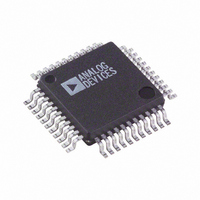AD7865BS-1 Analog Devices Inc, AD7865BS-1 Datasheet - Page 16

AD7865BS-1
Manufacturer Part Number
AD7865BS-1
Description
IC ADC 14BIT 4CH 5V 44-MQFP
Manufacturer
Analog Devices Inc
Specifications of AD7865BS-1
Rohs Status
RoHS non-compliant
Number Of Bits
14
Sampling Rate (per Second)
350k
Data Interface
Parallel
Number Of Converters
1
Power Dissipation (max)
160mW
Voltage Supply Source
Analog and Digital
Operating Temperature
-40°C ~ 85°C
Mounting Type
Surface Mount
Package / Case
44-MQFP, 44-PQFP
Available stocks
Company
Part Number
Manufacturer
Quantity
Price
Company:
Part Number:
AD7865BS-1
Manufacturer:
ADI
Quantity:
329
AD7865
The output spectrum from the ADC is evaluated by applying a
sine wave signal of very low distortion to the analog input. A
Fast Fourier Transform (FFT) plot is generated from which the
SNR data can be obtained. Figure 15 shows a typical 4096-
point FFT plot of the AD7865 with an input signal of 100 kHz
and a sampling frequency of 350 kHz. The SNR obtained from
this graph is 80.5 dB. It should be noted that the harmonics are
taken into account when calculating the SNR.
Effective Number of Bits
The formula given in Equation 1 relates the SNR to the number
of bits. Rewriting the formula, as in Equation 2, it is possible to
obtain a measure of performance expressed in effective number
of bits (N).
The effective number of bits for a device can be calculated di-
rectly from its measured SNR. Figure 16 shows a typical plot of
effective number of bits versus frequency for an AD7865-2.
Figure 14. Histogram of 8192 Conversions of a DC Input
–100
–120
–140
–20
–40
–60
–80
7000
6000
5000
4000
3000
2000
1000
0
N
0
0
SNR 1 76
6 02
35000
.
.
Figure 15. FFT Plot
70000
FREQUENCY – Hz
ADC CODE
105000
f s = 350kHz
f
SNR = 80.5dB
IN
140000
= 100kHz
175000
(2)
–16–
Intermodulation Distortion
With inputs consisting of sine waves at two frequencies, fa and
fb, any active device with nonlinearities will create distortion
products at sum and difference frequencies of mfa
m, n = 0, 1, 2, 3 . . ., etc. Intermodulation terms are those for
which neither m nor n are equal to zero. For example, the sec-
ond order terms include (fa + fb) and (fa – fb) while the third
order terms include (2fa + fb), (2fa – fb), (fa + 2fb) and (fa – 2fb).
The AD7865 is tested using two input frequencies. In this case
the second and third order terms are of different significance.
The second order terms are usually distanced in frequency from
the original sine waves while the third order terms are usually at
a frequency close to the input frequencies. As a result, the sec-
ond and third order terms are specified separately. The calcula-
tion of the intermodulation distortion is as per the THD specifi-
cation where it is the ratio of the rms sum of the individual
distortion products to the rms amplitude of the fundamental
expressed in dBs. In this case, the input consists of two, equal
amplitude, low distortion sine waves. Figure 17 shows a typical
IMD plot for the AD7865.
Figure 16. Effective Numbers of Bits vs. Frequency
–100
–120
–140
–20
–40
–60
–80
14
13
12
11
10
9
8
7
6
5
4
3
2
1
0
0
0
0
25000
50000
Figure 17. IMD Plot
INPUT FREQUENCY – kHz
100
FREQUENCY – Hz
75000
100000 125000
1000
f
f
f s = 350kHz
a
b
= 49.113kHz
= 50.183kHz
150000
–55 C
+125 C
+25 C
nfb where
10000
175000
REV. A













